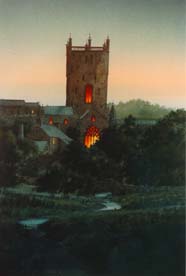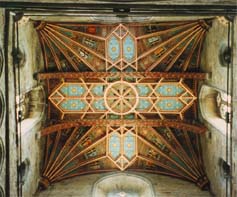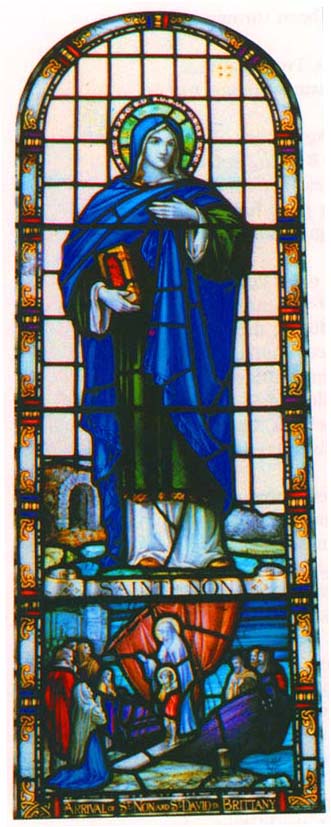ST DAVID'S, ST NONS AND ST DAVIDS
HEAD
ST NONS
This area is rich in Christian and
pre Christian sites. This overlap of cultures and historical epochs
is described by David James when he writes:
Close to St. Non's Well, about 100
yds distant, is the ancient ruined chapel built in the 6th century.
It is actually constructed within a prehistoric stone circle, a
perfect example of the continuity and convergence of beliefs. Yet in
some ways this is hardly surprising as the Scots-Gaelic for 'going to
church' is still, when translated, going to the stones'.
As well as the cathedral and St Nons
there is also St Davids Head where there are many signs of ancient
cultures. Also on a purely scenic level this area is outstandingly
beautiful with dramatic coastline and sea views.

ST DAVIDS CATHEDRAL
Revered as one of the major places
of pilgrimage in the Western world for over 1200 years, St Davids
cathedral is situated in a sheltered valley close to the south-west
tip of the Pembrokeshire coast in South Wales. To see it for the
first time is for many a wonder, standing as it does against a
backdrop of open fields and countryside in such a rural setting. The
original monastery of Menevia, founded by St. David himself in the
6th century, has long disappeared. It was pillaged several times by
Viking raiders in its history.The present cathedral was begun circa
1180 A.D., with additions over the centuries. St. David was born
close by, allegedly at the spot where St Non's well now stands. He is
known to have lived the life of a very ascetic Celtic monk, and
encouraged his followers to do likewise. He was known as 'the
waterman', some say because of his sparse food intake, but this could
easily refer to his frequent missionary travels by boat, which
included journeys to Brittany and Ireland. He was killed by Viking
raiders near the end of the 6th century, the exact date is not known.
lnterestingly his death was seen by some as retribution for eating
meat, as vegetarianism was one of the traditions of the Celtic
priesthood, and he was the first bishop to break this rule. The
earliest reference to St. David is in an 8th century book written at
Tallaght,ln Ireland, which reads that they 'kept the feast day of
David of Cille Muni', (the cell or church of Menevia), on March 1st.
Pope Calixtus 11, (1119-24), canonised St. David, and declared that
Two pilgrimages to Menevia were equal to one pilgrimage to Rome',
thus ensuring the Saint's popularity with medieval pilgrims. The
shrine of the Saint remains in the cathedral to this day, in the
beautiful and peaceful Trinity Chapel, the focal point for the Celtic
pilgrim. Today a pilgrimage to St. Davids is a truly exhilarating
experience. The area has a very ancient "feel" to it, with 6th
century St.Non's chapel (within a prehistoric stone circle), just two
miles distant. The small coves and bays nearby were the landing
places of the early pilgrims from Ireland, and also those from
Brittany and further afield. Visiting the cathedral at a quiet time
of the day there is a very strong sense of 'the old', and it is easy
to imagine the early and more basic structure of St.David's monastery
of Menevia being here prior to the present building. The carved
wooden suspended ceiling is the finest of its kind in existence, and
the painted wooden ceiling and vaulting beneath the tower is truly
magnificent.The picture below is taken looking directly upwards at
this wonderful ceiling.
 Almost everything about this Celtic
cathedral is unique, and it is hardly surprising that some people
have described it as "the eighth wonder of the world". The shrine of
St.David, behind the great altar, is a fine place to meditate, and
add ones appreciation for the beauty and inspiration of this place,
along with the thousands of pilgrims who have been here over the
centuries. There are some fine ancient Celtic cross slabs set into
the altar of the Trinity Chapel, and in a side chapel to the east is
another fine 9-1Oth century Celtic slab cross set into the wall. This
is called 'The stone of the sons of Bishop Abraham' (see sketch on
the previous page), and close by is another fragment of early Celtic
knotwork, reminders of the original monastery of Menevia. To
conclude, St.Davids must surely be one of the main focal points of
our Celtic Heritage, and certainly, once visited never
forgotten.
David James. Editor of Celtic
Connections.
An excellent book dedicated solely
to St.Davids is by Wyn Evans and Roger Worsley. "St.Davids Cathedral
1181-1981." This is a profusely illustrated hardback, available from
'Yr Oriel Fach ', St.Davids, Pembrokeshire, S. Wales.
Almost everything about this Celtic
cathedral is unique, and it is hardly surprising that some people
have described it as "the eighth wonder of the world". The shrine of
St.David, behind the great altar, is a fine place to meditate, and
add ones appreciation for the beauty and inspiration of this place,
along with the thousands of pilgrims who have been here over the
centuries. There are some fine ancient Celtic cross slabs set into
the altar of the Trinity Chapel, and in a side chapel to the east is
another fine 9-1Oth century Celtic slab cross set into the wall. This
is called 'The stone of the sons of Bishop Abraham' (see sketch on
the previous page), and close by is another fragment of early Celtic
knotwork, reminders of the original monastery of Menevia. To
conclude, St.Davids must surely be one of the main focal points of
our Celtic Heritage, and certainly, once visited never
forgotten.
David James. Editor of Celtic
Connections.
An excellent book dedicated solely
to St.Davids is by Wyn Evans and Roger Worsley. "St.Davids Cathedral
1181-1981." This is a profusely illustrated hardback, available from
'Yr Oriel Fach ', St.Davids, Pembrokeshire, S. Wales.
ST NONS
 Photograph of Stained Glass Window
in St Nons Chapel
Photograph of Stained Glass Window
in St Nons Chapel
ST. NON'S WELL
St. Non's well, situated on the edge
of the Pembrokeshire coast two miles West of St. David's cathedral,
is one of the finest examples of a Celtic healing well. The whole
location is in essence Celtic, and for the modern-day pilgrim is a
wonderful place to visit. The well has been used for healing purposes
at least since the time of St. Non, who was born in the early 6th
century, and probably for a considerable time before that. St. Non
was the mother St. David, the Patron Saint of Wales, (d. 589 A.D.)
who was reputed to have been born close to the well. He was the
founder of the original St. David's church and of Menevia in the late
6th century , on the site of what is now St. David's cathedral. Both
St. Non and St. David traveled extensively including visits to
Ireland and Brittany. Holy wells were an integral part of the
belief-system of the Celts. Many have been found to contain quartz
crystals, white quartz pebbles, and other offerings in them, as well
as Roman coins, indicating that their healing powers were also
accepted by outsiders. The Celts, like any other early civilization
required the basics of available food and water around which to build
their early settlements. Water was revered as a gift from Mother
Earth, and the very pure water of wells and springs was considered
especially sacred.
 Coastline around St Nons
Close to St. Non's Well, about 100
yds distant, is the ancient ruined chapel built in the 6th century.
It is actually constructed within a prehistoric stone circle, a
perfect example of the continuity and convergence of beliefs. Yet in
some ways this is hardly surprising as the Scots-Gaelic for 'going to
church' is still, when translated, going to the stones'. The only
carving within the ruined chapel is a very fine example an early slab
-cross, possibly earlier than the chapel itself. Very similar basic
cross-within-circle designs are found in all other Celtic countries.
Healing wells are very much 'alive' today, and St.Non's well is still
often used for its curative properties, as are many Ancient wells in
other Celtic countries. The object of writing about them is not to
encourage people to visit them like tourists, but that they should be
approached in a spirit of pilgrimage and revered as sacred places.
Many people have elaborate theories as to how the water is imbued
with healing properties, but the fact remains that whatever a
person's beliefs, the water from Holy wells has a beneficial effect
on the human body. A number of clergymen today are aware of this, and
hold annual healing services if there is a Holy well within their
parish. For those interested in the contemporary scientific field,
all healing wells tested have been found to contain a far higher
percentage of hydrogen peroxide than normal water. Hydrogen peroxide
has recently been successfully used in the treatment of certain cases
of cancer, leukemia,aids, as well as many other lesser ailments.
(Issue 1 Celtic Connections)
*Celtic Pembrokeshire
Home Page
*Gors Fawr Stone Circle and
the Presely Hills*Pentre Ifan,Tycanol, Nevern
and Carningli
*Some places of especial scenic
beauty. *Credits and Links to other
sites
* Accommodation
in Celtic Pembrokeshire
Coastline around St Nons
Close to St. Non's Well, about 100
yds distant, is the ancient ruined chapel built in the 6th century.
It is actually constructed within a prehistoric stone circle, a
perfect example of the continuity and convergence of beliefs. Yet in
some ways this is hardly surprising as the Scots-Gaelic for 'going to
church' is still, when translated, going to the stones'. The only
carving within the ruined chapel is a very fine example an early slab
-cross, possibly earlier than the chapel itself. Very similar basic
cross-within-circle designs are found in all other Celtic countries.
Healing wells are very much 'alive' today, and St.Non's well is still
often used for its curative properties, as are many Ancient wells in
other Celtic countries. The object of writing about them is not to
encourage people to visit them like tourists, but that they should be
approached in a spirit of pilgrimage and revered as sacred places.
Many people have elaborate theories as to how the water is imbued
with healing properties, but the fact remains that whatever a
person's beliefs, the water from Holy wells has a beneficial effect
on the human body. A number of clergymen today are aware of this, and
hold annual healing services if there is a Holy well within their
parish. For those interested in the contemporary scientific field,
all healing wells tested have been found to contain a far higher
percentage of hydrogen peroxide than normal water. Hydrogen peroxide
has recently been successfully used in the treatment of certain cases
of cancer, leukemia,aids, as well as many other lesser ailments.
(Issue 1 Celtic Connections)
*Celtic Pembrokeshire
Home Page
*Gors Fawr Stone Circle and
the Presely Hills*Pentre Ifan,Tycanol, Nevern
and Carningli
*Some places of especial scenic
beauty. *Credits and Links to other
sites
* Accommodation
in Celtic Pembrokeshire



